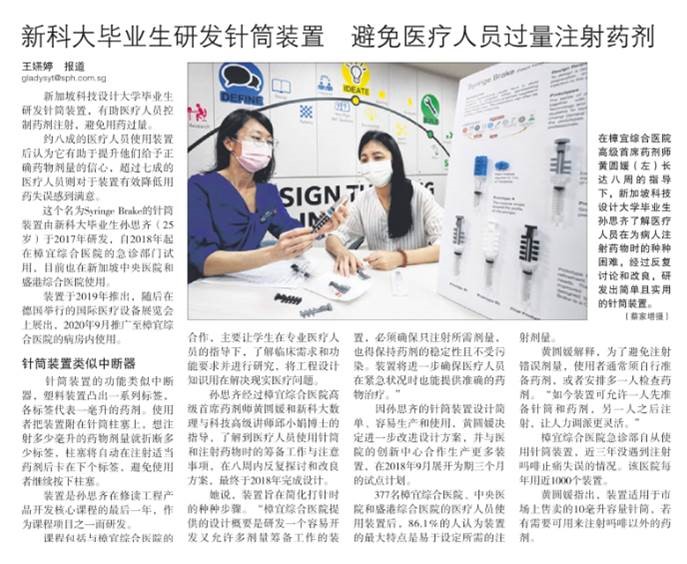SUTD graduate invents a syringe device to prevent medication dosing errors
Lianhe Zaobao, 11 Jan 2021, 新科大毕业生研发针筒装置 避免医疗人员过量注射药剂 (translation)
A graduate from the Singapore University of Technology and Design (SUTD) has developed a syringe device to help medical staff control the amount of medication delivered.
Approximately 80% of medical staff who have used the device felt that it helped increase their confidence in giving the correct dose of medication, and more than 70% of medical staff were satisfied that the device effectively reduces medication errors.
Known as the Syringe Brake, the device was developed in 2017 by SUTD graduate Felicia Soon (25 years old). It has been trialled in the emergency department of Changi General Hospital (CGH) since 2018, and is currently being used in Singapore General Hospital (SGH) and Sengkang General Hospital (SKH).
The device was launched in 2019 and was exhibited at the international medical equipment trade fair in Germany. It has been put to use in CGH wards since September 2020.
Syringe device similar to a brake
The syringe device functions like a brake. A series of labels protrude from the plastic device, with each label representing 1mL (millilitre) of medicine.
The user attaches the device to the plunger of the syringe and breaks as many labels as required to inject the correct amount of medicine in milliliters. The plunger will automatically be stopped by the next unbroken label after the appropriate amount of medicine has been injected, preventing the user from pressing the plunger further.
The device was the product of Felicia’s final year core course in engineering product development, and was developed from one of the course projects.
The course, a collaboration with CGH, focused mainly on allowing students to understand clinical needs and functional requirements, conducting research under the mentorship of professional medical staff, and using engineering design to solve real medical problems.
Felicia, under the guidance of CGH senior principal pharmacist, Yasmin Ng, and SUTD senior lecturer, Dr Khoo Xiaojuan, learned about the preparatory work and precautions undertaken by medical staff when using syringes and injecting medication. After eight weeks of back-and-forth discussions and improvements to her design, the design of the syringe brake device finally completed in 2018.
She said that the device simplifies the various steps required for administering injections. “The design brief provided by CGH was to invent a device that can be readily developed and allows for multi-dose preparations, ensuring that only the intended dose is injected while maintaining the sterility and stability of the medication. The device must further ensure that medical staff can inject accurate medication dosage even in emergency situations.”
As Felicia's syringe brake device was simple in design, easy to produce and use, Yasmin decided to further refine the design and collaborated with CGH's Office of Innovation to produce more devices. A three-month pilot programme was then launched in September 2018.
After 377 medical staff from CGH, SGH and SKH used the device, 86.1% believed that the best feature of the device was the ease of setting the required injection dosage.
Yasmin explained that in order to avoid injecting the wrong dose, users usually have to prepare their own medicines or arrange for one more person to check the medication. “Now the device allows one person to prepare the syringe and medication first, and another person to inject it later, optimising manpower.”
Since the CGH emergency department started using the syringe device, there has been no error in the dispensing of morphine injections for pain relief over the past three years. The hospital uses nearly 1,000 pieces of this device each year.
Yasmin pointed out that the device is suitable for 10mL syringes sold on the market, and can be used to inject drugs other than morphine if required.
